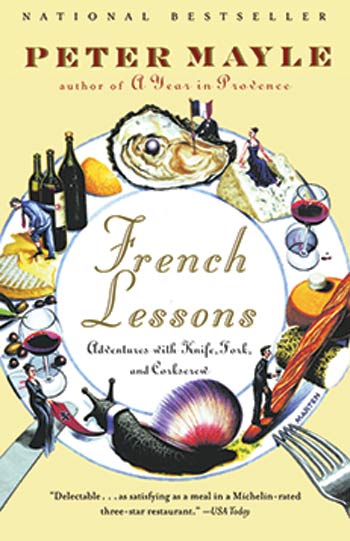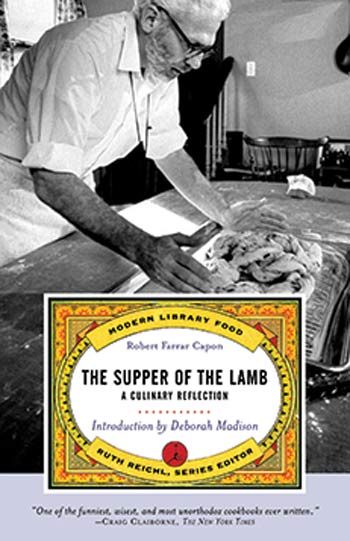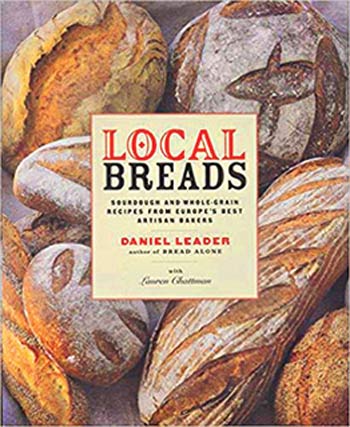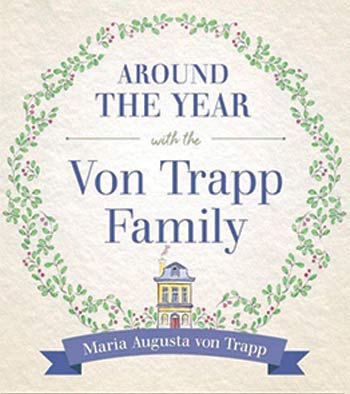Subtotal: $
Checkout
Next Article:
Explore Other Articles:

Peter Mayle’s French Lessons: Adventures with Knife, Fork, and Corkscrew (Vintage, 2002) is a culinary road trip through France. Mayle, an Englishman who describes his move to a two-hundred-year-old farmhouse in the Lubéron in A Year in Provence, now introduces readers to the small-town French love affair with food and drink. He writes with a gusto for the table, and a wit one might expect from a Brit living among the French. Chapters describe a frog leg festival in Vittel, the annual Foire aux Escargots in Martigny-les-Bains, and a wine tasting in Burgundy. There is also a chapter devoted to – obviously – a cheese festival, but another devoted to a messe de truffles, a Mass in honor of the truffle. Delightful characters abound, too: Régis, the supercilious lover of chicken; Sadler, another English food writer with a penchant for stinky cheese; and nameless table companions who argue about the best ways to cook and eat an omelet. French Lessons is the fruit of Mayle’s “long hours with knife and fork and glass that I like to call research” – hours we may relish with him in spirit, if not in stomach.

Julia Child’s My Life in France (Knopf, 2006; with Alex Prud’homme) chronicles the adventures of America’s most beloved chef during her years in Paris, Marseille, and Provence from 1948–1954. Child, writing at 92 years old, is a high-spirited and indefatigable narrator, charming readers with stories compiled from letters she and her husband Paul wrote to friends and family during those years. At the beginning of her marriage, Julia confesses she knew little about cooking. Her first meal as a bride – brains simmered in red wine – was a flop. But her arrival in France, and in particular, a lunch of sole meunière in Rouen, introduced her to the “revelation” of French home cooking, which would shape the rest of her life. Child describes classes at Le Cordon Bleu cooking school; her first attempts at French cuisine in their eccentric Parisian kitchen; beginning a cooking school, L’École des Gourmettes, with friends; and finally, her quest to compile a book of “French recipes for American cooks,” which would come to be known as Mastering the Art of French Cooking.

After reading the first chapter of Robert Farrar Capon’s The Supper of the Lamb: A Culinary Reflection (Modern Library, 1969), you will never cut an onion the same way again. The work is an unconventional, yet utterly delightful cookbook by an Episcopal priest with a passion for theology and cooking. Capon refreshes the reader’s appreciation for good food by challenging our tendency to ignore the material world in our quest for sanctity. “Food is the daily sacrament of unnecessary goodness,” he writes, “ordained for a continual remembrance that the world will always be more delicious than it is useful.” The book is loosely structured around a single recipe: Lamb for Eight Persons Four Times. There are many asides, in which Capon offers charmingly haphazard lectures on the glories of butter, essential kitchen gadgets, and how to throw a proper dinner party. He extols the turnip, “one of the lordliest vegetables in the world,” and the mushroom, “Ah! It is the proof of creation ex nihilo.” For all the whimsy, the theological reflection is precise and edifying. Before an appendix of bona fide recipes, Capon closes with a chapter for heartburn remedies. But there are two kinds of heartburn – one may be cured by a baking soda solution, the other (the “Higher Heartburn”) is a longing for heaven that can only be cured when we reach it. Yet “heaven does not run from the world but through it,” and so we offer God every good thing as we prepare to meet him. The Supper of the Lamb will leave the reader laughing, and longing for both a good meal and the Everlasting Banquet.

Be prepared to get flour all over Daniel Leader’s Local Breads (W. W. Norton, 2007). Leader, the founder and CEO of Bread Alone Bakery, visited bakers across Europe and compiled recipes from their centuries-old methods of maintaining sourdough starters and producing artisan breads. “Many of the recipes in this book come directly from a particular baker,” Leader writes, and he chronicles his encounters with characters like Stefano Galletti, a Florentine baker who proudly explains doppio zero flour, or Clemens Walch, who specializes in rye breads at his bakery in the Austrian Alps. The cookbook devotes three chapters to French breads – from the classic baguette and pain de campagne to darker breads from Auvergne; four chapters to Italian breads – featuring ciabatta, semolina sourdough, and a few pizza recipes; and two chapters to rye recipes from Germany, the Czech Republic, and Poland. Best of all, Leader gives detailed instructions on how to cultivate European starters and sourdoughs at home: the surest way to approximate bakery-bought bread in one’s own kitchen. There are also helpful troubleshooting sections for when loaves fall flat or starters lose their zip. Local Breads is perfect for the aspiring bread baker willing to invest the time to get it right.

Maria von Trapp’s Around the Year with the von Trapp Family (Sophia, 2018) has been reprinted for the first time since its original publication in 1955, giving a new generation of families the opportunity to celebrate religious feasts with prayers, songs, and recipes from the von Trapp family. Maria saw the Catholic liturgical year as a “school of living” that enlarges our understanding of “feast” by teaching us to celebrate in the Lord. Other Christian denominations will appreciate, too, her careful selection of traditions for Christmas, Lent, Easter, and occasions such as birthdays, graduations, and weddings. “It is the feast that helps to keep the family together,” she writes. Recipes – mostly sweets and breads – include sacher torte, a rich chocolate cake, for birthdays; unleavened bread for Lent; and lebkuchen, an Austrian gingerbread, for Advent.
Jane Peters is a doctoral candidate in historical theology at Marquette University. She lives in New York City with her husband, son, and cookbooks.
Already a subscriber? Sign in
Try 3 months of unlimited access. Start your FREE TRIAL today. Cancel anytime.























